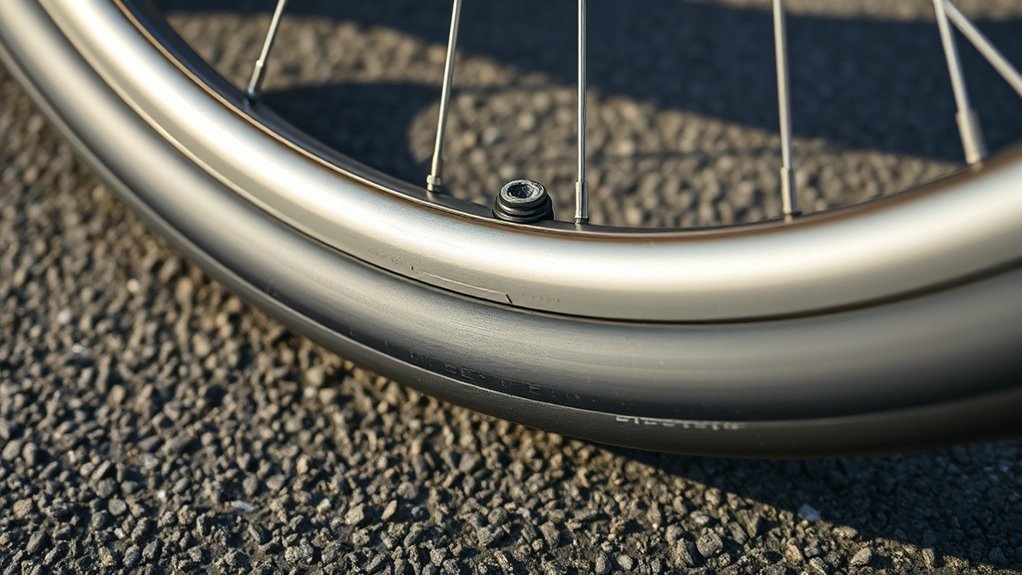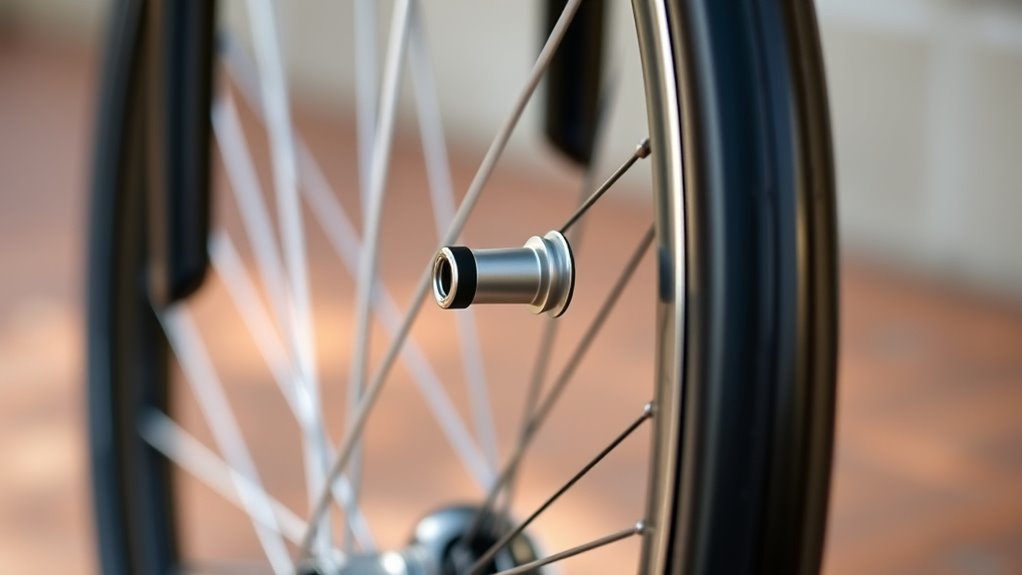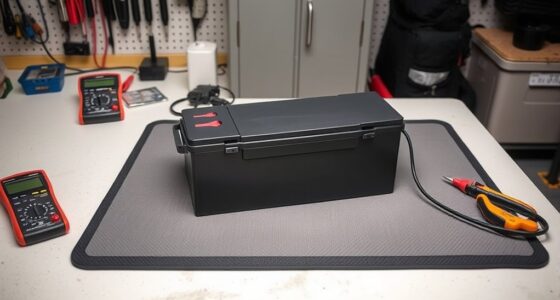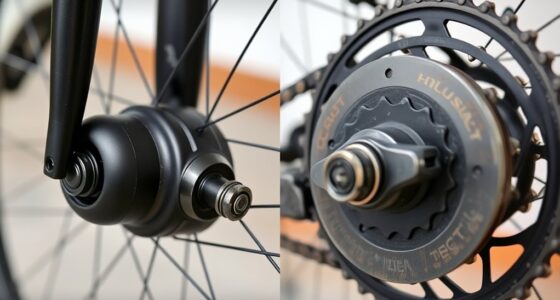Switching to tubeless on your e-bike can reduce flats, cut weight, and improve handling by eliminating inner tubes. It requires compatible rims, proper sealant application, and some initial effort to set up. Once installed, you’ll enjoy fewer punctures and smoother rides, but regular sealant maintenance is essential. While setup may seem challenging, the long-term benefits are worth it—if you want to learn more, there’s plenty to explore.
Key Takeaways
- Tubeless e-bike tires reduce flats with sealant, offering a more reliable and maintenance-friendly riding experience.
- Proper rim compatibility and rim tape are essential for effective tubeless setup and sealing.
- Installation involves removing inner tubes, applying rim tape, mounting tires, injecting sealant, and inflating to seal and seat beads.
- Regular sealant top-ups and wheel shaking are necessary for optimal performance and puncture repair.
- Benefits include weight savings, improved handling, and fewer flats, but initial setup and troubleshooting may require effort.

Switching to tubeless tires on your e-bike can considerably improve your riding experience by reducing flats and lowering overall weight. When you make the switch, one of the key factors to consider is tire sealant. This liquid, usually a latex-based solution, is injected into the tire chamber and works to quickly seal small punctures as they occur. It’s a game-changer because it minimizes the inconvenience of flats, especially on longer rides or rough terrain. However, before adding tire sealant, you need to ensure your rims are compatible with a tubeless setup. Not all rims are designed to be tubeless-ready, so checking rim compatibility is vital. Tubeless-compatible rims have specific bead profiles and sealing features that create an airtight seal with tubeless tires. If your rims aren’t compatible, you might need to invest in an upgrade, which can add to your initial expense, but the benefits often outweigh the costs.
The process begins with verifying that your rims are tubeless-ready. Look for markings on the rim or consult the manufacturer’s specifications. If they are compatible, installing tubeless tires involves removing the inner tube, fitting the tubeless rim tape securely around the rim bed, and then mounting the tubeless tire onto the rim. Once the tire is in place, you pour in the tire sealant through the valve stem, which usually has a removable core for easy filling. Shaking the wheel ensures the sealant coats the inside of the tire evenly, providing an extra layer of sealant coverage for punctures. After filling, you inflate the tire to the recommended pressure, listening for a pop or feeling for a tight seat to confirm the bead is properly seated. It’s often helpful to spin and bounce the wheel to distribute the sealant and guarantee a proper seal. Regularly checking and topping off your sealant is also necessary, as it can dry out over time, especially in varying climates.
While tubeless systems require some initial setup effort, they offer significant advantages once running smoothly. The sealant acts quickly to patch small punctures, and the reduced weight from eliminating the inner tube can improve your bike’s handling and efficiency. Keep in mind, though, that maintaining a tubeless setup involves periodic top-offs of sealant, as it gradually dries out over several months. Also, if you’re switching from traditional tires, be prepared for a few troubleshooting steps to get everything sealed correctly, especially with rim compatibility issues or stubborn bead seating. Overall, tubeless for e-bikes can make your rides more reliable and enjoyable, provided you pay attention to rim compatibility and keep your tire sealant topped up. Proper retirement planning strategies, such as understanding state-specific tax laws, can help you preserve and maximize your savings for future needs.
Frequently Asked Questions
How Often Should Tubeless Tires Be Checked for Sealant Refills?
You should check your tubeless tires for sealant evaporation and refill them every 2 to 6 months, depending on riding conditions. Sealant gradually dries out or evaporates, reducing its effectiveness at sealing punctures. Regularly inspecting the tire and topping off the sealant guarantees peak performance and prevents flats. Keep an eye out for low sealant levels, especially if you notice more frequent punctures or diminished tubeless performance.
Can Tubeless Setups Be Used With All E-Bike Tire Sizes?
Yes, tubeless setups can be used with many e-bike tire sizes, but you need to verify tire compatibility first. Not all tires are designed for tubeless use, so confirm if your specific size and model support tubeless technology. Keep in mind, some size limitations might exist, especially with very narrow or very wide tires, so always consult your e-bike manufacturer’s recommendations to ensure proper fit and safety.
What Is the Typical Lifespan of Tubeless Sealant on E-Bikes?
The typical lifespan of tubeless sealant on e-bikes is about 2 to 6 months, depending on usage and conditions. Sealant longevity varies with factors like climate, tire size, and riding frequency. To guarantee ideal tire maintenance, check your sealant regularly and top it off when needed. Keeping an eye on sealant levels prevents flats and maintains good sealing performance, especially since e-bikes often see more wear and tear.
Are Tubeless Tires More Prone to Punctures Under Heavy E-Bike Loads?
Yes, tubeless tires can have a higher puncture frequency under heavy e-bike loads because the increased load impact stresses the tire and sealant more, making punctures slightly more likely. However, tubeless setups often still perform well, as the sealant quickly seals small punctures. To minimize puncture risk, verify your tires are properly inflated and the sealant is fresh, especially when riding with heavy loads.
How Do Tubeless Setups Affect E-Bike Battery Efficiency?
Tubeless setups can improve your e-bike’s battery efficiency by allowing you to maximize tire pressure, reducing rolling resistance. Proper tire pressure minimizes energy loss, helping your battery last longer. However, sealant evaporation rates can affect pressure stability over time, so regular checks are essential. Maintaining ideal pressure not only boosts efficiency but also ensures your tires stay well-sealed, giving you a smoother ride and better battery life.
Conclusion
Switching to tubeless for your e-bike is like upgrading from a tricycle to a racing bike—you gain speed, control, and fewer flats. I once rode a trail with a friend who swore by tubeless; he finished faster and with fewer worries. Remember, while tubeless setups require some effort upfront, they pay off in smoother rides and fewer surprises. Embrace the change, and you’ll find your e-bike experience more effortless and enjoyable—just like revealing a new level of riding confidence.









